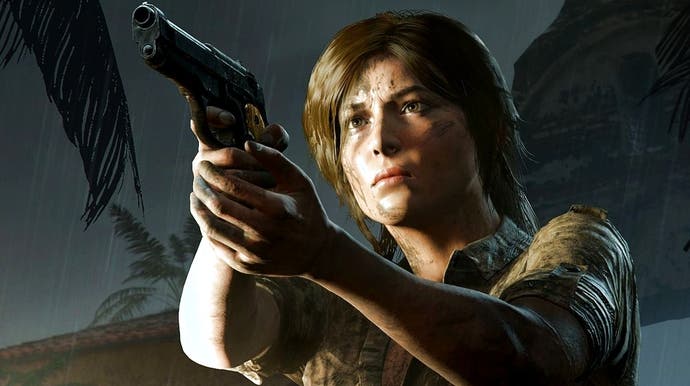Shadow of Tomb Raider's PS5 and Xbox Series patch tested
Can we hit 4K resolution at 60fps?
A surprise update recently arrived for Shadow of the Tomb Raider, giving the best of both worlds for PlayStation 5 and Xbox Series X consoles: a high resolution that looks great on 4K displays, in addition to a 60fps target. And if the consistency of the frame-rate isn't good enough for you, the legacy 1080p performance mode remains. In our opinion, the revised quality mode is the one to play, and the differences in how PS5 and Xbox Series X deliver it is intriguing.
At the base level, Shadow of the Tomb Raider on Xbox Series consoles now enjoys an official 'optimised for Series X/S' patch label, suggesting a native app, while the upgrade is still flagged as a PlayStation 4 title when running on PS5. However, it's pretty clear that despite the new labelling on Xbox, the game is still running on the older XDK - it hasn't been ported to the new GDK and so doesn't tap into the more advanced features of the RDNA 2 GPU. We can ascertain this simply because the game looks and runs exactly as it did via Microsoft's FPS Boost upgrade: performance is identical, resolutions are the same - 2016p on Series X, 900p on Series S. The difference for Microsoft machines is that a progression bug introduced by FPS Boost is now addressed. In effect, FPS Boost is made official by Square-Enix and the bug is gone.
The changes for PlayStation 5 running the game under backwards compatibility are more interesting. The resolution mode operates at 1872p with a 30fps cap on PS4 Pro and until the patch arrived, it was the same on PlayStation 5. However, Square-Enix has switched things up now: Pro is still running at 1872p but the PS5 runs at 2160p, with performance enhanced via the accelerant that is checkerboard rendering. It's an interesting choice by the developer - the suggestion is that 60fps could not have been achieved by retaining the original release. Checkerboarding lowers the pixel count but allows the PS5 to deliver a higher level of performance.
Although the resolution mode targets 60fps - and does a pretty good job overall - neither PS5 or Series X can lock to it, so the 1080p performance mode still has a role to play, albeit of reduced significance. It essentially removes all of the remaining GPU-level bottlenecks and gets a flatline 60fps, the only remaining dips to performance coming from minor blips linked to camera cuts during cinematics. Many games do this: it's a means to start rendering effects like motion blur, and even physics effects, with an extra frame to buffer and ensures even TAA treatment to all frames.
As for how Series X and PS5 compare in their respective resolution modes, the Microsoft machine is pushing many more pixels than its Sony counterpart, giving a marginal lead overall in image quality. Meanwhile, PlayStation 5 gets significantly closer to the target 60 frames per second, struggling only in areas with a lot of transparency effects - the flood sequence early on in the game is the ultimate workout.
Series X is basically the same, but with less stability and more performance drops. Again, alpha effects are the primary culprit: the crash of waves and even transparency-heavy woodland areas see the console play out continuously in the 50s. It's great to see the resolution stay in line with the Xbox One X version, but you can't help but feel it pays a price for it - though if you're playing on a variable refresh rate display, the impact is diminished.
In comparing the two consoles in resolution mode, we're given an interesting contrast. There's no doubt that PS5 delivers smoother performance: the 4K checkerboard technique works well and generally allows for a tighter lock at 60fps. Series X has a clearer image - one closer to a true 4K in raw detail, but in motion, the detail break-up you experience with PS5's checkerboard rendering is disguised by the game's TAA and motion blur. It's a strong use of the technique that gets it close enough to pass as a native presentation. The savings PS5 also gets in frame-rate terms can be stark too. At some points we're seeing a lead of around 10fps in PS5's favour, and it rings true as a more optimal 'up to' 60fps experience.
Of course, we should mention Xbox Series S too. The reality of this version is that it hits 60fps with any issue whatsoever, at least from the first few hours. Even the worst hit areas in Series X do not trouble the Series S. It's a superb lock at 60fps, but the 900p resolution is a bit of a downer: it's not that you get aliasing artefacts or shimmer, you just get a reduction in clarity. It's a bit tooblurry. The net result isn't all too flattering to look at on a big 4K screen, though at the very least a smoother frame-rate is locked down. Really though, a 1080p60 option would have been a good bonus.
Ultimately, this is an interesting patch. On Xbox Series consoles, Shadow of the Tomb Raider patch 2.01 essentially makes the FPS Boost upgrade official, delivering identical performance but addressing the progression bug. Meanwhile, the changes to PS5 are more substantial - it's one of the few backwards compatibility upgrades we've seen that actually changes resolution in addition to removing the frame-rate cap. Checkerboarding works well in both cutting down resolution with a minimal hit to image quality while at the same time allowing the console to power on to a mostly locked 60fps. Regardless of platform though, a great game has received an even better way to play - and if nothing else, it's a new excuse to play it if you haven't already, or to revisit it if you have. The game still looks stunning and benefits tremendously from the performance upgrade.






.png?width=291&height=164&fit=crop&quality=80&format=jpg&auto=webp)









